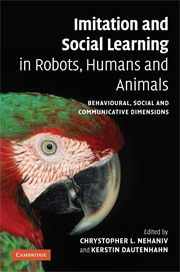 Imitation and Social Learning in Robots, Humans and Animals
Imitation and Social Learning in Robots, Humans and Animals Book contents
- Frontmatter
- Contents
- List of plates
- List of figures
- List of tables
- List of contributors
- Introduction: the constructive interdisciplinary viewpoint for understanding mechanisms and models of imitation and social learning
- Part I Correspondence problems and mechanisms
- Part II Mirroring and ‘mind-reading’
- Part III What to imitate?
- Part IV Development and embodiment
- Part V Synchrony and turn-taking as communicative mechanisms
- Part VI Why imitate? – Motivations
- Part VII Social feedback
- Part VIII The ecological context
- Index
- Plate section
Part I - Correspondence problems and mechanisms
Published online by Cambridge University Press: 10 December 2009
- Frontmatter
- Contents
- List of plates
- List of figures
- List of tables
- List of contributors
- Introduction: the constructive interdisciplinary viewpoint for understanding mechanisms and models of imitation and social learning
- Part I Correspondence problems and mechanisms
- Part II Mirroring and ‘mind-reading’
- Part III What to imitate?
- Part IV Development and embodiment
- Part V Synchrony and turn-taking as communicative mechanisms
- Part VI Why imitate? – Motivations
- Part VII Social feedback
- Part VIII The ecological context
- Index
- Plate section
Summary
The problem for one individual of producing behaviour that matches, in some aspect, with behaviour it observes in another comprises an instance of the correspondence problem (compare Part IV, Development and embodiment, this volume; Nehaniv and Dautenhahn, 2002). The particular nature of the kind of similarity that is matched determines different classes of correspondence problems. The bodies and affordances available to the two individuals are in general not the same, so the problem is non-trivial – even ignoring the complexities of perception in registering the observed behaviour. Mechanisms for solving these correspondence problems are numerous, and, while generally occurring in a social context, they may or may not involve learning. On the other hand, every social learning mechanism solves a particular class of correspondence problems.
Geoffrey Bird and Cecilia Heyes discuss several alternative mechanisms for solving correspondence problems in which the observer must generate motor commands to match visual input. Of particular interest due to the complexity of mechanism they appear to require for their solution are cases in which the perceptual discrepancies cannot be used as simple feedback to guide mismatch reduction and achieve matching behaviour. Various levels of such perceptual opacity occur when the visual experience in observing another individual and the experience which occurs when carrying out the ‘same’ actions are dissimilar, as in a curtsy bow or in playing tennis.
- Type
- Chapter
- Information
- Imitation and Social Learning in Robots, Humans and AnimalsBehavioural, Social and Communicative Dimensions, pp. 19 - 22Publisher: Cambridge University PressPrint publication year: 2007


